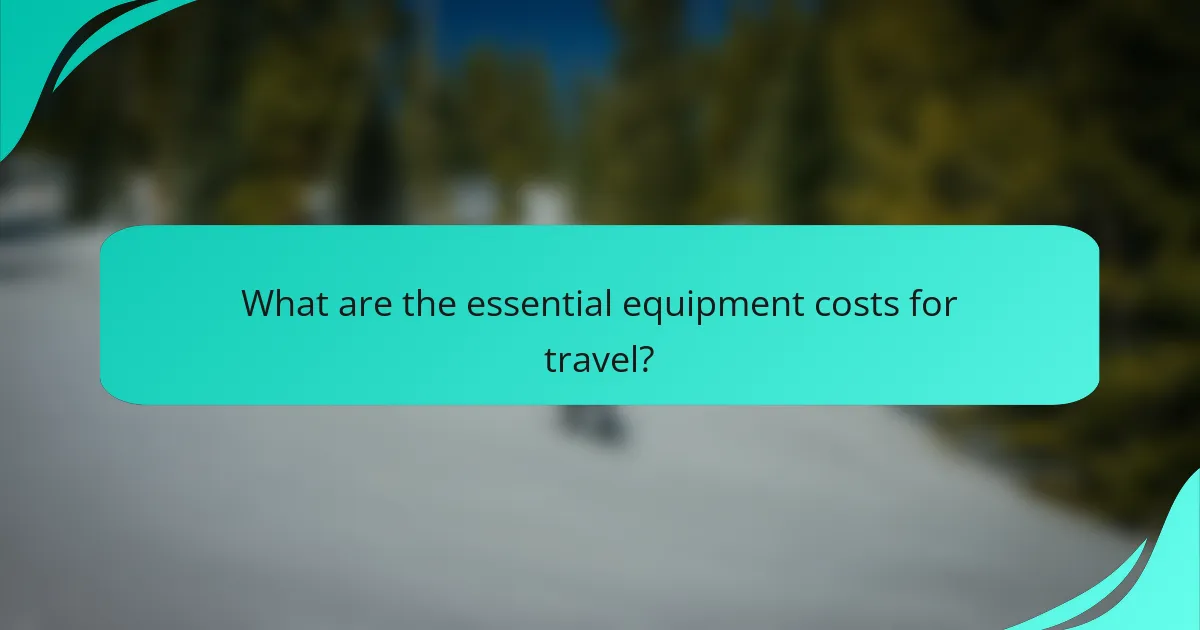Budgeting for travel and equipment is essential for a successful trip, as it helps you manage expenses related to transportation, accommodation, food, and activities. By estimating your total costs and utilizing budgeting tools, you can create a realistic spending plan that accommodates necessary equipment purchases, such as luggage and electronics, while allowing for adjustments along the way. This proactive approach ensures you can enjoy your travel experience without financial strain.

How to budget for travel in the United States?
To budget for travel in the United States, start by estimating your total costs, including transportation, accommodation, food, and activities. Consider using a budgeting tool to track your expenses and adjust your plans as needed to stay within your financial limits.
Average travel costs in the US
The average travel costs in the US can vary widely based on location and time of year. On average, travelers might spend around $150 to $300 per day, which includes accommodation, meals, and activities. Major cities like New York or San Francisco tend to be on the higher end of this range, while smaller towns may offer more affordable options.
Transportation costs, such as flights or car rentals, can add significantly to your budget. Domestic flights typically range from $100 to $400, while car rentals can cost between $30 and $100 per day, depending on the vehicle type and rental duration.
Budgeting tools for US travelers
Several budgeting tools can help US travelers manage their expenses effectively. Apps like Mint or YNAB (You Need A Budget) allow you to set spending limits and track your transactions in real-time. These tools can help you visualize your budget and adjust your spending habits accordingly.
Additionally, spreadsheets can be a simple yet effective way to plan your travel budget. Create categories for each expense type and input estimated costs to see how they align with your overall budget. This method offers flexibility and customization based on your travel style.
Best practices for saving on travel expenses
To save on travel expenses, consider booking flights and accommodations well in advance, as prices tend to rise closer to the departure date. Look for deals during off-peak seasons, which can significantly lower costs. Signing up for fare alerts can also help you snag lower prices.
Utilizing public transportation instead of taxis or rideshares can further reduce expenses. Additionally, consider dining at local eateries rather than tourist spots, as they often offer more affordable and authentic meals. Always keep an eye out for discounts or packages that combine activities for added savings.

What are the essential equipment costs for travel?
Essential equipment costs for travel typically include items like luggage, clothing, electronics, and safety gear. Depending on the type of travel and destination, these costs can vary significantly, often ranging from a few hundred to several thousand dollars.
Types of travel equipment and their prices
Travel equipment can be categorized into several types, including luggage, clothing, and electronics. For instance, a durable suitcase may cost between $100 and $300, while a quality backpack can range from $50 to $200. Clothing costs can vary widely based on brand and material, with travel-specific clothing often priced higher.
Electronics such as cameras, laptops, or portable chargers are also essential. A decent travel camera might set you back $300 to $1,000, while a reliable power bank can cost around $20 to $50. Safety gear, including first aid kits and travel insurance, should also be factored into your budget.
Budget-friendly travel gear options
To save on travel equipment costs, consider purchasing second-hand gear or renting items you may not use frequently. Websites and local stores often have good deals on gently used luggage and outdoor equipment. Additionally, many brands offer budget lines that maintain quality while reducing costs.
Another option is to look for sales during off-peak seasons or during major shopping events. Websites that specialize in travel gear often have clearance sections where you can find high-quality items at a fraction of the original price. Always compare prices and read reviews to ensure you’re getting the best value for your money.

How to plan a travel budget effectively?
To plan a travel budget effectively, start by estimating all potential expenses and setting a realistic spending limit. This approach helps ensure you can enjoy your trip without financial stress, allowing for adjustments as needed.
Steps to create a travel budget
Begin by listing all possible costs associated with your trip, including transportation, accommodation, food, activities, and souvenirs. Research average prices in your destination to create a more accurate estimate.
Next, categorize these expenses into fixed costs, like flights and hotel bookings, and variable costs, such as meals and entertainment. This distinction helps you identify areas where you can cut back if necessary.
Finally, set aside a contingency fund, typically around 10-20% of your total budget, to cover unexpected expenses. This buffer can alleviate stress during your travels.
Common budgeting mistakes to avoid
A frequent mistake is underestimating daily expenses, particularly for meals and activities. Travelers often overlook small costs that can add up quickly, so it’s wise to track these items closely.
Another common pitfall is failing to account for currency exchange rates and fees, which can significantly impact your budget. Be sure to check current rates and consider using a travel-friendly credit card to minimize fees.
Lastly, avoid neglecting travel insurance costs. While it may seem like an unnecessary expense, having coverage can save you from significant financial losses in case of emergencies or cancellations.

What resources can help with travel budgeting?
Various resources can assist with travel budgeting, including apps, websites, and tools designed to track expenses and compare costs. Utilizing these resources can help travelers manage their finances effectively, ensuring they stay within their budget while enjoying their trips.
Top budgeting apps for travelers
Budgeting apps are essential for travelers looking to keep track of their expenses on the go. Popular options include Mint, which allows users to set budgets and monitor spending, and Trail Wallet, specifically designed for travelers to log expenses by day and category. These apps often provide visual insights into spending habits, making it easier to adjust budgets as needed.
When choosing a budgeting app, consider features like currency conversion, offline access, and user interface. Some apps may charge a fee or offer premium features, so evaluate what fits your travel style and budget best.
Websites for comparing travel costs
Websites that compare travel costs can save you money by helping you find the best deals on flights, accommodations, and activities. Sites like Kayak and Skyscanner allow users to search multiple airlines and travel agencies simultaneously, providing a comprehensive view of available options. Additionally, platforms like Trivago focus on hotel comparisons, ensuring you get the best rates.
When using these websites, be mindful of hidden fees and terms that may affect the final price. It’s often beneficial to check multiple sites and book directly with airlines or hotels when possible, as they may offer exclusive discounts or perks.

How do travel costs vary by destination?
Travel costs can significantly differ based on the destination due to factors like local economy, demand, and available amenities. Popular tourist spots often have higher expenses, while less frequented locations may offer more budget-friendly options.
Cost comparisons between popular US cities
When comparing travel costs among major US cities, New York City and San Francisco typically rank as the most expensive, with daily expenses often exceeding $200. In contrast, cities like Nashville and Austin provide a more affordable experience, with daily costs ranging from $100 to $150.
Accommodation is a major factor in these comparisons. For instance, a hotel in New York might average $300 per night, while a similar hotel in Austin could be around $150. Dining and entertainment also contribute to the overall budget, with prices varying widely.
Factors affecting travel costs in different regions
Several factors influence travel costs across regions, including seasonal demand, local attractions, and transportation options. High tourist seasons can drive prices up, especially in coastal areas or cities hosting major events.
Additionally, the cost of living in a region plays a crucial role. For example, cities with a high cost of living, like Los Angeles, often have higher prices for food, lodging, and activities compared to cities with a lower cost of living, such as Denver.
Lastly, the availability of budget airlines and public transportation can affect overall travel expenses. Regions with robust public transit systems may allow travelers to save significantly on transportation costs, making them more appealing for budget-conscious visitors.

What are the benefits of using a travel budget?
Using a travel budget helps you manage your expenses effectively, ensuring you can enjoy your trip without financial stress. It allows for better planning and prioritization of spending, leading to a more satisfying travel experience.
Financial control during trips
Establishing a travel budget gives you financial control by setting clear limits on how much you can spend each day. This prevents overspending and encourages you to make informed choices about accommodations, meals, and activities.
To maintain control, consider allocating specific amounts for different categories, such as lodging, food, and entertainment. For example, you might set aside 40% for accommodations, 30% for food, and 30% for activities. Adjust these percentages based on your travel style and destination.
Enhanced travel experience through budgeting
A well-planned budget enhances your travel experience by allowing you to allocate funds toward meaningful experiences rather than unnecessary expenses. This can lead to discovering local attractions or dining at unique restaurants that fit within your budget.
Additionally, budgeting can reduce stress associated with financial uncertainty while traveling. Knowing you have a plan in place allows you to focus on enjoying your trip rather than worrying about running out of money. Aim to track your spending daily to ensure you stay on target and make adjustments as needed.

What trends are emerging in travel budgeting?
Emerging trends in travel budgeting focus on flexibility, technology integration, and sustainability. Travelers are increasingly using apps and online tools to track expenses and find cost-effective options, while also prioritizing eco-friendly choices that may influence their overall budget.
Increased use of budgeting apps
Travelers are turning to budgeting apps to manage their expenses more effectively. These applications allow users to set spending limits, track costs in real-time, and receive alerts when they approach their budget. Popular options include Mint, YNAB (You Need A Budget), and Trail Wallet.
Using these tools can help travelers stay organized and avoid overspending. Many apps also provide insights into spending habits, enabling users to adjust their budgets for future trips based on past experiences.
Focus on sustainable travel
Sustainable travel is becoming a priority for many, influencing how budgets are allocated. Travelers are willing to invest more in eco-friendly accommodations, local experiences, and carbon offset programs. This shift often leads to higher upfront costs but can result in long-term savings through reduced environmental impact.
For example, choosing public transportation over rental cars can lower costs while supporting local economies. Budgeting for sustainable options may require more planning but aligns with growing consumer values around environmental responsibility.
Flexible travel planning
Flexibility in travel planning is increasingly important, especially in light of recent global events. Many travelers are opting for refundable bookings and travel insurance to protect their investments. This trend allows for adjustments without incurring significant financial losses.
When budgeting, consider allocating funds for potential changes in plans. Setting aside a contingency fund of around 10-15% of the total budget can provide a safety net for unexpected expenses or changes in itinerary.
